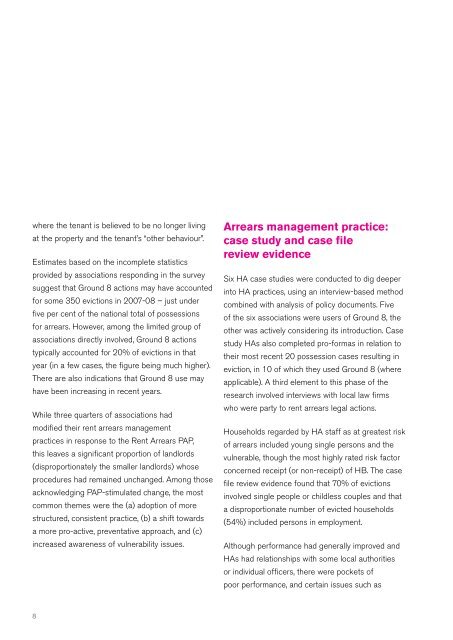Rent arrears management practices in the housing association sector
Rent arrears management practices in the housing association sector
Rent arrears management practices in the housing association sector
Create successful ePaper yourself
Turn your PDF publications into a flip-book with our unique Google optimized e-Paper software.
where <strong>the</strong> tenant is believed to be no longer liv<strong>in</strong>g<br />
at <strong>the</strong> property and <strong>the</strong> tenant’s “o<strong>the</strong>r behaviour” .<br />
Estimates based on <strong>the</strong> <strong>in</strong>complete statistics<br />
provided by <strong>association</strong>s respond<strong>in</strong>g <strong>in</strong> <strong>the</strong> survey<br />
suggest that Ground 8 actions may have accounted<br />
for some 350 evictions <strong>in</strong> 2007-08 – just under<br />
five per cent of <strong>the</strong> national total of possessions<br />
for <strong>arrears</strong> . However, among <strong>the</strong> limited group of<br />
<strong>association</strong>s directly <strong>in</strong>volved, Ground 8 actions<br />
typically accounted for 20% of evictions <strong>in</strong> that<br />
year (<strong>in</strong> a few cases, <strong>the</strong> figure be<strong>in</strong>g much higher) .<br />
There are also <strong>in</strong>dications that Ground 8 use may<br />
have been <strong>in</strong>creas<strong>in</strong>g <strong>in</strong> recent years .<br />
While three quarters of <strong>association</strong>s had<br />
modified <strong>the</strong>ir rent <strong>arrears</strong> <strong>management</strong><br />
<strong>practices</strong> <strong>in</strong> response to <strong>the</strong> <strong>Rent</strong> Arrears PAP,<br />
this leaves a significant proportion of landlords<br />
(disproportionately <strong>the</strong> smaller landlords) whose<br />
procedures had rema<strong>in</strong>ed unchanged . Among those<br />
acknowledg<strong>in</strong>g PAP-stimulated change, <strong>the</strong> most<br />
common <strong>the</strong>mes were <strong>the</strong> (a) adoption of more<br />
structured, consistent practice, (b) a shift towards<br />
a more pro-active, preventative approach, and (c)<br />
<strong>in</strong>creased awareness of vulnerability issues .<br />
8<br />
Arrears <strong>management</strong> practice:<br />
case study and case file<br />
review evidence<br />
Six HA case studies were conducted to dig deeper<br />
<strong>in</strong>to HA <strong>practices</strong>, us<strong>in</strong>g an <strong>in</strong>terview-based method<br />
comb<strong>in</strong>ed with analysis of policy documents . Five<br />
of <strong>the</strong> six <strong>association</strong>s were users of Ground 8, <strong>the</strong><br />
o<strong>the</strong>r was actively consider<strong>in</strong>g its <strong>in</strong>troduction . Case<br />
study HAs also completed pro-formas <strong>in</strong> relation to<br />
<strong>the</strong>ir most recent 20 possession cases result<strong>in</strong>g <strong>in</strong><br />
eviction, <strong>in</strong> 10 of which <strong>the</strong>y used Ground 8 (where<br />
applicable) . A third element to this phase of <strong>the</strong><br />
research <strong>in</strong>volved <strong>in</strong>terviews with local law firms<br />
who were party to rent <strong>arrears</strong> legal actions .<br />
Households regarded by HA staff as at greatest risk<br />
of <strong>arrears</strong> <strong>in</strong>cluded young s<strong>in</strong>gle persons and <strong>the</strong><br />
vulnerable, though <strong>the</strong> most highly rated risk factor<br />
concerned receipt (or non-receipt) of HB . The case<br />
file review evidence found that 70% of evictions<br />
<strong>in</strong>volved s<strong>in</strong>gle people or childless couples and that<br />
a disproportionate number of evicted households<br />
(54%) <strong>in</strong>cluded persons <strong>in</strong> employment .<br />
Although performance had generally improved and<br />
HAs had relationships with some local authorities<br />
or <strong>in</strong>dividual officers, <strong>the</strong>re were pockets of<br />
poor performance, and certa<strong>in</strong> issues such as




